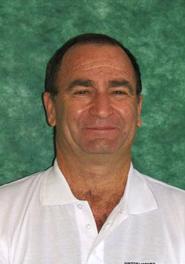
Haim Goren, associate professor at Tel-Hai College in Israel’s Upper Galilee, presented the Couper Phi Beta Kappa Lecture at Hamilton on Sept. 24. Established in 2005 to honor Richard “Dick” Couper ’44 and his wife Patsy, this annual lecture series features eminent speakers who present on topics pertaining to the Burke Library’s special collections.
The author of five scholarly books, Goren received his Ph.D. from the Hebrew University in Jerusalem, and resides currently in the Upper Galilee, just south of Israel’s Lebanese border. Goren has spent the last few weeks at Hamilton, working closely with the Burke Library to locate and identify artifacts and books owned by Edward Robinson, the subject of his lecture, and has spent the past few years studying Robinson’s life and work. His lecture served as a compilation of his research thus far.
Goren’s talk titled “Edward Robinson: ‘Father of the Scientific Study of the Holy Land,’” told the story of Robinson, one of history’s leading biblical scholars, and alumnus of Hamilton’s charter class of 1816. The son of a preacher-gone-farmer, Robinson was a Connecticut native whose uncle was one of the first professors here. Goren noted that in Robinson’s journals, he refers to his time at Hamilton as “living in the forests next to wigwams of the Indians.” Robinson was also briefly married to Hamilton founder Samuel Kirkland’s daughter, before her early death.
After his Central New York sojourn, Robinson went on to Newton, Mass., where he studied under biblical scholar Moses Stuart at the esteemed Andover Seminary, which Goren explained was “known for its conservatism.” At Andover, he studied Hebrew, shortly being appointed to a tutoring position. He also became quite invested in Hebrew lexicography. His most valuable educational experiences, however, came in his advanced studies in Europe. Robinson traveled to Paris, Berlin and several other cities, where he studied comparative linguistics and became fluent in German as well.
Robinson’s most notable work in biblical geography and archeology was done in the 1830s alongside friend and Reverend Eli Smith. This scholarly pairing “sought to prove… the value of the Holy Scriptures as a geographical and historical source,” Goren declared. Together, they traveled to Egypt, Israel, Asia Minor, and worked with a map-printing house in Beirut, where Robison acquired a fluency in Arabic.
He even assisted in the first-ever Arabic translation of the Bible. “They traveled off the beaten tracks,” Goren recounted. “They were not afraid to ask questions…even when they were against the religious views” of the time. In their travels through the Holy Land, Smith and Robinson were not interested in what they saw as proving the present, but rather as “showing the past.” They sought to concentrate on biblical geography, researching only historical periods, principally Christianity. Goren proposed that without Smith, Robinson would not have been able to reach the results he did.
An erudite linguist, author, geographer, cartographer and biblical archaeology researcher, Edward Robinson was a fascinating man who “simply never wasted a moment of his life.” To commemorate his history, Hamilton has compiled his bibliography throughout the 20th and 21st centuries, collecting a combination of archives and publications, which Goren assures are diverse sources for critical reading and understanding. Accompanied by a visual slideshow and real-life artifacts from the Library’s collections, Goren’s well-attended lecture provided an in-depth look at one of the most interesting and learned men in the history of Hamilton and the world.
Posted September 25, 2014
